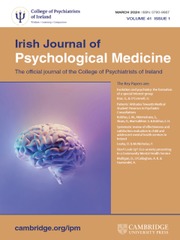No CrossRef data available.
Article contents
Experience and attitudes in relation to telepsychiatry use among non-consultant doctors
Published online by Cambridge University Press: 26 December 2024
Abstract
In order to minimise physical interaction during the COVID-19 pandemic, telepsychiatry became a key part of clinical practice for many psychiatrists.
This study involved an exploratory, cross-sectional, opt-in online survey circulated to non-consultant doctors in psychiatry working in Ireland. It assessed experience and attitudes in relation to telepsychiatry use.
The response rate was 11.6% (n = 61). Forty-eight individuals (78.6%) had delivered clinical care using telepsychiatry. Fifty-nine individuals (96.7%) were unfamiliar with telepsychiatry prior to the pandemic. Most respondents had not received specific training around use of a telepsychiatry platform (86.9%, n = 63) and were unaware of published guidelines around its optimal use (54.1%, n = 33). Respondents’ concerns included issues around connectivity, medico-legal uncertainty and clinical effectiveness.
Conclusions drawn are limited by the potential for selection bias in this study. Nonetheless the paper has highlighted important issues including the need for more research assessing telepsychiatry clinical and curricular experience. Additional curricular interventions during training could build skillset and confidence in telepsychiatry.
Keywords
- Type
- Short Report
- Information
- Copyright
- © The Author(s), 2024. Published by Cambridge University Press on behalf of College of Psychiatrists of Ireland


